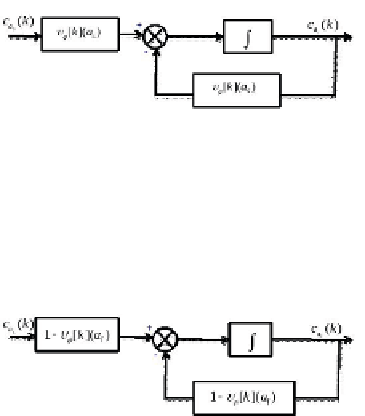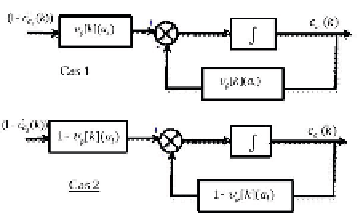Information Technology Reference
In-Depth Information
Fig. 1.
Synergistic Exchange
c
a
l
(
k
+1)
−
c
a
l
(
k
)=(
c
a
s
(
k
)
−
c
a
l
(
k
))
v
φ
[
k
](
a
s
)
, which is equivalent to:
c
a
l
(
k
+1)=
c
a
l
(
k
)+(
c
a
s
(
k
)
−
c
a
l
(
k
))
v
φ
[
k
](
a
s
)
.
Fig. 2.
Revisionist Exchange
Revisionist Exchange.
In this situation, agent
a
l
understands the argument of agent
a
s
,
who has the same preference but a more moderate support. Agent
a
s
appears to speak
with restraint relative to
a
l
's point of view, and this exposes
a
l
's doubt.
a
l
's conviction
is thus mitigated by
a
s
's intervention. This situation, which is depicted in figure 2,
corresponds to the case when
a
l
and
a
s
have the same preference with
c
a
l
>c
a
s
.The
intuitive difference equation is then written as:
c
a
l
(
k
+1)
−
c
a
l
(
k
)=(
c
a
l
(
k
)
−
c
a
s
(
k
))(1
−
v
φ
[
k
](
a
l
))
which is equivalent to:
c
a
l
(
k
+1)=
c
a
s
(
k
)+(
c
a
l
(
k
)
c
a
s
(
k
))
v
φ
[
k
](
a
l
)
.
Agent
a
l
observes the indecision on the part of agent
a
s
who nevertheless shares his
opinion:
a
s
contributes to
a
l
's doubt. The level of conviction decreases due to
a
s
's
intervention. which is proportional on the one hand to
1
−
v
φ
[
k
](
a
l
)
(resulting from
a
l
's
lack of assurance relative to his social position within the group) and on the other hand
to the difference between both agents' convictions.
−
Fig. 3.
Antagonistic Exchange


